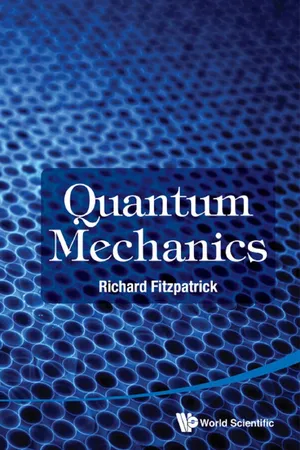![]()
Chapter 1
Fundamental Concepts
1.1Breakdown of Classical Physics
The necessity for a departure from classical physics at the microscopic (i.e., atomic, molecular, and particle) level is amply demonstrated by the following well-known phenomena:
Anomalous Atomic and Molecular Stability: According to classical physics, an electron orbiting an atomic nucleus undergoes acceleration and should, therefore, lose energy via the continuous emission of electromagnetic radiation [Fitzpatrick (2008)], causing it to gradually spiral in towards the nucleus. (See Exercise 1.1.) Experimentally, this is not observed to happen.
Anomalously Low Atomic and Molecular Specific Heats: According to the equipartition theorem of classical statistical thermodynamics, each degree of freedom of an atom or molecule should contribute R/2 to the molar specific heat capacity of a macroscopic system made up of a great many such atoms or molecules, where R is the molar ideal gas constant [Reif (1965)]. In fact, only the translational, and some rotational, degrees of freedom seem to contribute. The vibrational degrees of freedom appear to make no contribution at all (except at very high temperatures) [Reif (1965)]. Incidentally, this fundamental problem with classical physics was known and appreciated by the middle of the nineteenth century. Stories that physicists at the commencement of the twentieth century thought that classical physics explained everything, and that there was nothing left to discover, are largely apocryphal [Feynman et al. (1963)].
Ultraviolet Catastrophe: According to classical statistical thermodynamics, the equilibrium energy density of an electromagnetic field contained within a vacuum cavity whose walls are held at a fixed temperature is infinite, due to a divergence of energy carried by short-wavelength modes. This divergence is called the ultraviolet catastrophe [Ehrenfest (1911)]. Experimentally, there is no such divergence, and the total energy density is finite [Reif (1965)].
Wave-Particle Duality: Classical physics treats waves and microscopic particles as completely distinct phenomena. However, various experiments (e.g., the photoelectric effect [Einstein (1905); Millikan (1916)], Compton scattering [Compton (1923)], and electron diffraction [Davisson (1928); Thomson (1928)]) demonstrate that waves sometimes act as if they were streams of particles, and streams of particles sometimes act as if they were waves [de Broglie (1925)]. This behavior is completely inexplicable within the framework of classical physics.
1.2Photon Polarization
We know experimentally that if plane polarized light is used to eject photo-electrons then there is a preferred direction of emission of the electrons [Bubb (1924)]. Clearly, the polarization properties of light, which are usually associated with its wave-like behavior, also extend to its particle-like behavior. In particular, a polarization can be ascribed to each individual photon (i.e., quantum of electromagnetic radiation) in a beam of light.
Consider the following well-known experiment. A beam of plane polarized light is passed through a thin polarizing film whose plane is normal to the beam’s direction of propagation, and which has the property that it is only transparent to light whose direction of polarization lies perpendicular to its optic axis (which is assumed to lie in the plane of the film). Classical electromagnetic wave theory tells us that if the beam is polarized perpendicular to the optic axis then all of the light is transmitted, if the beam is polarized parallel to the optic axis then none of the light is transmitted, and if the light is polarized at an angle α to the axis then a fraction sin2α of the beam energy is transmitted—the latter result is known as Malus’ law [Hecht and Zajac (1974)]. Let us try to account for these observations at the individual photon level.
A beam of light that is plane polarized in a certain direction is presumably made up of a stream of photons that are each plane polarized in that direction. This picture leads to no difficulty if the direction of polarization lies parallel or perpendicular to the optic axis of the polarizing film. In the former case, none of the photons are transmitted, and, in the latter case, all of the photons are transmitted. But, what happens in the case of an obliquely polarized incident beam?
The previous question is not very precise. Let us reformulate it as a question relating to the result of some experiment that we could perform. Suppose that we were to fire a single photon at a polarizing film, and then look to see whether or not it emerges on the other side. The possible results of the experiment are that either a whole photon (whose energy is equal to the energy of the incident photon) is observed, or no photon is observed. Any photon that is transmitted though the film must be polarized perpendicular to the film’s optic axis. Furthermore, it is impossible to imagine (in physics) finding part of a photon on the other side of the film. If we repeat the experiment a great number of times then, on average, a fraction sin2α of the photons are transmitted through the film, and a fraction cos2α are absorbed. Thus, given that the trials are statistically independent of one another, we must conclude that an individual photon has a probability sin2α of being transmitted as a photon polarized in the plane perpendicular to the optic axis, and a probability cos2α of being absorbed. T...
